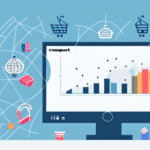How Much Can You Earn Selling on Amazon? A Guide to Pricing Your Products
If you're looking to start selling on Amazon, one of the most critical aspects of your strategy will be pricing your products. Your pricing strategy will determine how competitive your products are and ultimately how much you can earn from sales. In this guide, we will cover everything you need to know about pricing products on Amazon, including understanding the Amazon marketplace, determining your profit margin, researching your competition, utilizing pricing tools, and much more.
Understanding the Amazon Marketplace
Amazon is one of the largest e-commerce marketplaces in the world. With over 2.5 million active sellers, it’s a highly competitive environment. However, Amazon's extensive reach and reputation can be a massive advantage for sellers looking to expand their businesses. As you begin selling on Amazon, it is crucial to understand the different marketplaces and the fees associated with each one.
One of the benefits of selling on Amazon is access to their vast customer base. With over 300 million active users, Amazon provides sellers with a platform to reach a global audience. Additionally, Amazon offers various tools and services to help sellers optimize their listings and increase sales, such as Amazon Advertising and Amazon FBA (Fulfillment by Amazon).
However, with these benefits come challenges. The competition on Amazon can be fierce, and sellers need to differentiate themselves to stand out. This can be achieved through various strategies, such as offering unique products, providing excellent customer service, and optimizing product listings for search engines. It's also important to stay up-to-date with Amazon's policies and guidelines to avoid account suspension or other penalties.
Finding and Evaluating Products to Sell
Before you worry about pricing your products, you need to find products to sell on Amazon. The most successful sellers on Amazon have a deep understanding of the market and its trends. They research their competition and look for product opportunities that fit their potential customers' needs and wants. You can use methods like product research tools, trend analysis, and customer feedback to find the right products to sell.
Product Research Strategies
Utilize product research tools to identify trending products and analyze market demand. Trend analysis helps in understanding the popularity of products over time, while customer feedback provides insights into customer preferences and potential improvements for your products.
Assessing Market Demand and Competition
One important factor to consider when finding products to sell on Amazon is the level of competition in the market. While it's important to choose a product that has demand, it's also crucial to select a product with a manageable level of competition. Highly competitive markets can make it difficult to stand out and make sales, especially for new sellers. Therefore, it's important to strike a balance between demand and competition when selecting products to sell on Amazon.
Pricing Strategies for Amazon Sellers
Determining the right pricing strategy is essential for maximizing profits and remaining competitive on Amazon.
Understanding the Value of Your Product
Before you can price your products, you need to have an understanding of their true value. This includes the costs of production, packaging, and shipping. It's also important to consider your brand and the value it carries to your potential customers. What makes your product unique? Why should someone choose you over your competition?
Another important factor to consider when determining the value of your product is the market demand. Conducting market research can help you understand the needs and preferences of your target audience, and how much they are willing to pay for your product. Additionally, you should also take into account any external factors that may affect the perceived value of your product, such as economic trends or changes in consumer behavior.
Determining Your Profit Margin
Your profit margin is the difference between your product's cost and the price you sell it for. It's important to keep in mind that Amazon charges fees, and shipping costs will also impact your profit margin. You need to factor all of these costs into your pricing strategy to ensure that you're making a profit.
Another important factor to consider when determining your profit margin is your competition. You need to research your competitors' pricing strategies and ensure that your prices are competitive. However, you also need to make sure that you're not underpricing your products and leaving money on the table. Finding the right balance between competitiveness and profitability is key to a successful pricing strategy.
Using Customer Reviews to Inform Pricing
Customer reviews are essential to the success of your product on Amazon. They can affect your sales performance, your ranking in the marketplace, and even your pricing strategy. Positive customer reviews can help you justify a higher price point, while negative reviews may force you to lower your prices to remain competitive.
Furthermore, customer reviews can provide valuable feedback on your product's quality, features, and overall performance. This feedback can help you identify areas for improvement and make necessary changes to your product to better meet the needs and expectations of your customers. By taking customer feedback into consideration, you can not only improve your product but also increase customer satisfaction and loyalty.
Setting a Competitive Price Point
Setting a competitive price point is critical to your sales success. It's important to balance your product's value with the competition, fees, and other costs to ensure that you're making the most profit while still remaining competitive.
One way to determine a competitive price point is to conduct market research and analyze the prices of similar products in your industry. This can help you understand the average price range and adjust your pricing strategy accordingly.
Another factor to consider when setting a price point is your target audience. Understanding their purchasing power and willingness to pay can help you determine the optimal price point for your product.
Avoiding Common Pricing Pitfalls
There are many common pricing pitfalls that sellers encounter when selling on Amazon. These include underpricing your products, overpricing your products, and not factoring in all the costs of selling on Amazon.
One of the most important factors to consider when pricing your products on Amazon is your competition. It's important to research and analyze the prices of similar products being sold by other sellers on the platform. This will help you determine a competitive price point for your own products and avoid underpricing or overpricing them.
Utilizing Amazon's Tools and Strategies
Amazon provides sellers with various tools and strategies to help them manage their pricing and increase their sales.
Automated Pricing Tools
One of the most popular pricing tools on Amazon is the automated repricing tool. This tool allows sellers to automatically adjust their prices based on the prices of their competitors. This can help sellers stay competitive and win the Buy Box, which is the box on the product detail page where customers can begin the purchasing process by adding items to their shopping carts.
Promotions and Deals
In addition to automated pricing tools, Amazon also offers promotional opportunities such as Lightning Deals and Coupons. Lightning Deals are limited-time promotions that offer a significant discount on a product, while Coupons allow sellers to offer a discount on a product for a longer period of time. These promotional opportunities can help sellers increase their sales and visibility on the platform.
Fulfillment Options
Amazon offers various fulfillment options, including Fulfillment by Amazon (FBA) and Merchant Fulfilled Network (MFN). These options can significantly boost your profits while improving your customer's experience. It's worth considering which option is right for your business.
Monitoring and Adjusting Your Strategy
Your pricing strategy is not set in stone. You'll need to monitor your sales performance and adjust your prices over time to remain competitive. The marketplace is constantly changing, and your pricing strategy needs to keep up with it.
Evaluating the Success of Your Pricing Strategy
It's essential to evaluate the success of your pricing strategy over time. Use analytics tools like Amazon's sales reports to evaluate your performance and determine if adjustments are necessary. If you're not achieving the desired results, it may be time to revisit your pricing strategy.
Adjusting Prices Over Time
One way to monitor your sales performance is to track your sales data regularly. This will help you identify trends and patterns in your sales, and determine whether your pricing strategy is effective or not. You can use this information to make informed decisions about adjusting your prices.
Another factor to consider when adjusting your prices is your target audience. If you're targeting a price-sensitive market, you may need to adjust your prices more frequently to remain competitive. On the other hand, if you're targeting a premium market, you may be able to maintain higher prices for longer periods of time.
Maximizing Profits with Promotions and Deals
Promotions and deals are among the most effective ways to maximize your profits on Amazon. You can use various promotions, including Lightning Deals and Coupons, to draw customers to your products and generate sales.
However, it's important to carefully plan and execute your promotions to ensure they are profitable for your business. Offering too many discounts or running promotions too frequently can lead to decreased profit margins and a devaluation of your products in the eyes of customers. It's also important to track the success of your promotions and adjust your strategy accordingly. By finding the right balance and using promotions strategically, you can increase sales and boost your profits.
Staying Competitive in a Crowded Marketplace
Staying competitive in a crowded marketplace requires constant effort. You need to remain attentive to market trends, analyze your competition, and offer excellent customer service to maintain your competitive edge.
One effective way to stay competitive is to continuously innovate and improve your products or services. This can involve investing in research and development, seeking customer feedback, and keeping up with emerging technologies. By staying ahead of the curve, you can differentiate yourself from your competitors and attract new customers.
Working with Amazon's Fulfillment Options to Increase Profits
Amazon offers various fulfillment options, including Fulfillment by Amazon (FBA) and Merchant Fulfilled Network (MFN). These options can significantly boost your profits while improving your customer's experience. FBA handles storage, packaging, and shipping, allowing you to focus on other aspects of your business. MFN gives you more control over your inventory but requires you to manage fulfillment processes yourself.
Conclusion
Deciding how much to price your products on Amazon requires a deep understanding of the market, your competition, and your costs. By utilizing these pricing strategies and tools, you can develop a pricing strategy that helps you maximize your profits while staying competitive in the marketplace. Regularly evaluate and adjust your strategies to adapt to changing market conditions and consumer behaviors, ensuring sustained success on Amazon.




















